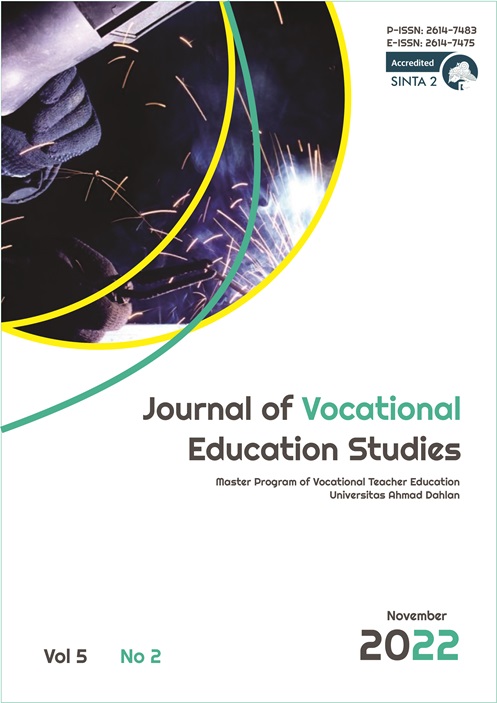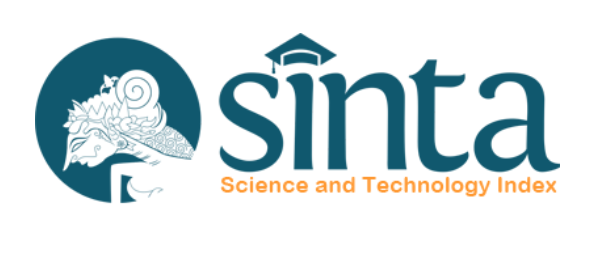Collaborative Concept Mapping: A Study of Group Work Satisfaction in Vocational Higher Education
DOI:
https://doi.org/10.12928/joves.v5i2.6181Keywords:
Computer-supported collaborative learning, Collaboration learning, Knowledge collaboration, Concept mappingAbstract
Collaboration is gaining traction in today's educational environment. Thus, teachers' primary concern is assisting students in experiencing group knowledge collaboration. As online education continues to grow in popularity, there is an increasing need to promote and understand collaborative learning processes. Its success is contingent upon implementing online collaborative learning strategies that foster critical thinking abilities while also providing meaningful collaborative learning opportunities. Collaborative concept mapping is one tool that could be used to foster student collaboration. Rather than creating and visualizing ideas individually, collaborative concept mapping involves two or more students working collaboratively to create one or more concept maps. In collaborative learning, interactions between learners are critical sources of idea generation. The purpose of this study is to examine students’ satisfaction with implementing the strategy in Second Language Reading class. The recent study advances our understanding of how to effectively use collaborative teaching tools in the classroom and improve student learning through group collaboration. The study's findings indicate that students demonstrated positive attitudes toward group collaboration, as evidenced by collaborative concept mapping. In addition, the collaborative learning processes embedded in concept mapping learning platforms support and facilitate reading comprehension achievement, resulting in successful foreign language learning for higher education students. The interaction in collaborative concept mapping, lacking in individual concept mapping, has facilitated individual and group knowledge building. As a result, implementing this strategy may benefit both group and individual learning.
References
Bixler, G. M., Brown, A., Way, D., Ledford, C., & Mahan, J. D. (2015). Collaborative concept mapping and critical thinking in fourth-year medical students. Clinical Pediatrics, 54(9), 833–839. https://doi.org/10.1177%2F0009922815590223
Braun, V., & Clarke, V. (2006). Using thematic analysis in psychology. Qualitative Research in Psychology, 3(2), 77–101. https://doi.org/https://doi.org/10.1191/1478088706qp063oa
Chang, C.-C., Liu, G.-Y., Chen, K.-J., Huang, C.-H., Lai, Y.-M., & Yeh, T.-K. (2017). The effects of a collaborative computer-based concept mapping strategy on Geographic Science performance in Junior High School students. Eurasia Journal of Mathematics, Science and Technology Education, 13(8), 5049–5060. https://doi.org/https://doi.org/10.12973/eurasia.2017.00981a
Chang, C.-C., Yeh, T.-K., & Shih, C.-M. (2016). The effects of integrating computer-based concept mapping for physics learning in junior high school. Eurasia Journal of Mathematics, Science and Technology Education, 12(9), 2531–2542. https://doi.org/https://doi.org/10.12973/eurasia.2016.1284a
Cheung, R., & Vogel, D. (2013). Predicting user acceptance of collaborative technologies: An extension of the technology acceptance model for e-learning. Computers & Education, 63, 160–175.
Chiu, C.-H., Huang, C.-C., & Chang, W.-T. (2000). The evaluation and influence of interaction in networks supported collaborative concept mapping. Computers & Education, 34(1), 17–25. https://doi.org/https://doi.org/10.1016/S0360-1315(99)00025-1
Farrokhnia, M., Pijeira-Díaz, H. J., Noroozi, O., & Hatami, J. (2019). Computer-supported collaborative concept mapping: The effects of different instructional designs on conceptual understanding and knowledge co-construction. Computers & Education, 142, 103640. https://doi.org/https://doi.org/10.1016/j.compedu.2019.103640
Fink, A. (2003). How to design survey studies. Sage.
Gao, H., Shen, E., Losh, S., & Turner, J. (2007). A review of studies on collaborative concept mapping: What have we learned about the technique, and what is next? Journal of Interactive Learning Research, 18(4), 479–492.
Gijlers, H., & de Jong, T. (2013). Using concept maps to facilitate collaborative simulation-based inquiry learning. Journal of the Learning Sciences, 22(3), 340–374. https://doi.org/https://doi.org/10.1080/10508406.2012.748664
Ibrahim, N., Shak, M. S. Y., Mohd, T., Ismail, N. A., Perumal, P. D. a/p, Zaidi, A., & Yasin, S. M. A. (2015). The Importance of Implementing Collaborative Learning in the English as a Second Language (ESL) Classroom in Malaysia. Procedia Economics and Finance, 31, 346–353. https://doi.org/10.1016/S2212-5671(15)01208-3
Jonassen, D. H., & Strobel, J. (2006). I was modeling for meaningful learning. In Engaged learning with emerging technologies (pp. 1–27). Springer. https://doi.org/https://doi.org/10.1007/1-4020-3669-8_1
Komis, V., Avouris, N., & Fidas, C. (2002). Computer-supported collaborative concept mapping: Study of synchronous peer interaction. Education and Information Technologies, 7(2), 169–188. https://doi.org/https://doi.org/10.1023/A:1020309927987
Kwon, S. Y., & Cifuentes, L. (2009). The comparative effect of individually-constructed vs. collaboratively-constructed computer-based concept maps. Computers & Education, 52(2), 365–375. https://doi.org/https://doi.org/10.1016/j.compedu.2008.09.012
Lailiyah, M., Setiyaningsih, L. A., Wediyantoro, P. L., & Yustisia, K. K. (2021). Assessing an effective collaboration in higher education: A study of students’ experiences and challenges on group collaboration. EnJourMe (English Journal of Merdeka): Culture, Language, and Teaching of English, 6(2), 97–105.
Lailiyah, M., & Wediyantoro, P. L. (2021). Critical thinking in second language learning : Students’ attitudes and beliefs. International Journal of Language Education, 5(3), 180–192. https://doi.org/https://doi.org/10.26858/ijole.v5i3.18350
McNeil, S. G., Robin, B. R., & Miller, R. M. (2000). Facilitating interaction, communication, and collaboration in online courses. Computers & Geosciences, 26(6), 699–708. https://doi.org/https://doi.org/10.1016/S0098-3004(99)00106-5
Muindi, E. N., Mwania, J. M., & Metet, J. (2017). Influence of collaboration as a conflict management style on academic performance in secondary schools in Makueni Sub-County, Makueni County, Kenya.
Pinandito, A., Hayashi, Y., & Hirashima, T. (2021). Online Collaborative Kit-Build Concept Map: Learning Effect and Conversation Analysis in Collaborative Learning of English as a Foreign Language Reading Comprehension. IEICE Transactions on Information and Systems, E104.D(7), 981–991. https://doi.org/10.1587/transinf.2020EDP7245
Ojima, M. (2006). Concept mapping as pre-task planning: A case study of three Japanese ESL writers. System, 34(4), 566–585.
Soller, A. (2001). Supporting social interaction in an intelligent collaborative learning system. International Journal of Artificial Intelligence in Education (IJAIED), 12, 40–62.
Stump, G. S., Hilpert, J. C., Husman, J., Chung, W. T., & Kim, W. (2011). Collaborative learning in engineering students: Gender and achievement. Journal of Engineering Education, 100(3), 475–497. https://doi.org/10.1002/j.2168-9830.2011.tb00023.x
Tseng, H., Ku, H.-Y., Wang, C.-H., & Sun, L. (2009). Critical factors in online collaboration and their relationship to teamwork satisfaction. Quarterly Review of Distance Education, 10(2).
Tyran, C. K., & Shepherd, M. (2001). Collaborative technology in the classroom: A review of the GSS research and a research framework. Information Technology and Management, 2(4), 395–418. https://doi.org/10.1023/A:1011450617798
Uribe, D., Klein, J. D., & Sullivan, H. (2003). The effect of computer-mediated collaborative learning on solving III-defined problems. Educational Technology Research and Development, 51(1), 5–19. https://doi.org/https://doi.org/10.1007/BF02504514
Van Boxtel, C., van der Linden, J., Roelofs, E., & Erkens, G. (2002). Collaborative concept mapping: Provoking and supporting meaningful discourse. Theory into Practice, 41(1), 40–46.
Wediyantoro, P. L., Lailiyah, M., & Yustisia, K. K. (2020). Synchronous discussion in online learning: Investigating students’ critical thinking. EnJourMe (English Journal of Merdeka) : Culture, Language, and Teaching of English, 5(2), 196–203. https://doi.org/10.26905/enjourme.v5i2.5205
Downloads
Published
Issue
Section
License
Copyright (c) 2022 Universitas Ahmad Dahlan

This work is licensed under a Creative Commons Attribution-ShareAlike 4.0 International License.
Authors who publish with Journal of Vocational Education Studies (JOVES) agree to the following terms: Authors retain the copyright and grant the Universitas Ahmad Dahlan right of first publication with the work simultaneously licensed under a Creative Commons Attribution License (CC BY-SA 4.0) that allows others to share (copy and redistribute the material in any medium or format) and adapt (remix, transform, and build upon the material) the work for any purpose, even commercially with an acknowledgement of the work's authorship and initial publication in Universitas Ahmad Dahlan. Authors are able to enter into separate, additional contractual arrangements for the non-exclusive distribution of the journal's published version of the work (e.g., post it to an institutional repository or publish it in a book), with an acknowledgement of its initial publication in Universitas Ahmad Dahlan. Authors are permitted and encouraged to post their work online (e.g., in institutional repositories or on their website) prior to and during the submission process, as it can lead to productive exchanges, as well as earlier and greater citation of published work (See The Effect of Open Access).










.png)



